Professional 3D printed jewelry combines advanced material science with precision engineering to achieve what traditional methods can’t. You’ll need mastery of CAD software, layer resolution control between 25-100 microns, and premium metals like gold, silver, and titanium through Direct Metal Laser Sintering. Quality standards include non-toxic castable resins, rigorous testing protocols, and industry-leading equipment certification. Your competitive edge comes from rapid prototyping capabilities and complex geometric designs that deliver luxury aesthetics with structural integrity—explore these essential elements further.
Advanced Material Science and Premium Metal Options
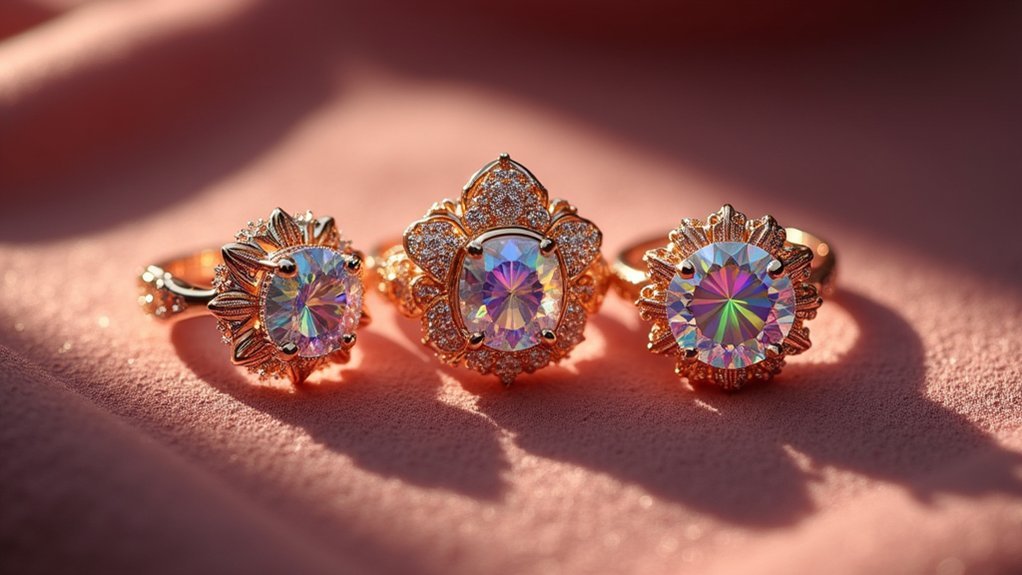
While traditional jewelry-making relies on time-tested techniques, 3D printing revolutionizes the craft through advanced material science that reveals premium metal options previously impossible to work with.
You’ll find that Direct Metal Laser Sintering enables you to work with gold, silver, and titanium, creating intricate designs with exceptional strength and precision.
The breakthrough in castable resins means you can capture fine details and produce complex geometries that traditional methods can’t achieve.
These high-quality materials guarantee your jewelry pieces maintain durability while showcasing unprecedented design complexity.
You’re no longer limited by conventional manufacturing constraints.
Premium metal options combined with innovative material science allow you to create pieces that blend luxury aesthetics with structural integrity, opening doors to possibilities that weren’t feasible before.
Precision Engineering Through Digital Design Workflows
You’ll achieve professional-grade jewelry through mastering CAD software that captures intricate details impossible with traditional methods.
Your 3D printer’s layer resolution directly determines the final piece’s precision, making proper calibration essential for meeting industry standards.
You can optimize your entire workflow by integrating digital design tools with casting methods, enabling quick iterations while reducing material waste.
CAD Software Design Mastery
When designing 3D printed jewelry, CAD software becomes your most powerful tool for achieving precision that traditional methods can’t match.
You’ll find that mastering programs like Autodesk 3ds Max and Fusion 360 opens up complex geometries impossible with hand-carving techniques. Your digital workflow enables rapid prototyping, letting you iterate quickly based on client feedback and testing results.
You’ll visualize and manipulate 3D models with exceptional accuracy before production begins. This CAD software mastery streamlines your shift from digital design to 3D printing, maintaining intended detail and quality throughout the process.
You’ll also reduce material waste and production costs by effectively planning and optimizing your jewelry design creations. The customizable features available through advanced CAD programs give you creative freedom while ensuring professional-grade precision in every piece.
Layer Resolution Control Standards
Layer resolution stands as the cornerstone of precision in 3D printed jewelry, where every micron determines whether intricate details emerge as intended or disappear into rough approximations.
Your layer resolution management directly impacts the quality of complex geometries, from delicate filigree patterns to sophisticated pavé settings that define fine jewelry.
You’ll want to optimize layer thickness between 25-100 microns using CAD software for most applications. However, advanced technologies like SLA and DLP push boundaries further, achieving 10-micron resolution for exceptional detail reproduction.
This precision eliminates the guesswork traditional methods often require.
Maintaining consistent layer resolution management standards across production batches ensures every piece meets professional expectations.
Finer layers deliver smoother surfaces requiring minimal post-processing, while preserving the structural integrity that clients demand from premium jewelry pieces.
Workflow Integration Optimization Methods
Achieving ideal layer resolution means nothing without streamlined workflows that transform your digital designs into flawless physical jewelry.
Workflow integration requires CAD software that seamlessly connects to advanced 3D printing technology like material jetting and direct metal laser sintering. You’ll dramatically reduce production time by integrating digital tools with traditional casting methods, eliminating costly manual labor while maintaining precision.
Your jewelry manufacturing process benefits from immediate client feedback and real-time collaboration capabilities. This integration allows you to modify designs instantly, ensuring higher satisfaction rates and superior final products.
Specialized 3D printers building layer by layer achieve intricate details that traditional methods can’t replicate. You’re empowered to create custom features and unique pieces that meet market demands for innovation, positioning your work at the forefront of professional jewelry design.
Complex Geometries That Traditional Methods Cannot Achieve
While traditional jewelry-making techniques have served craftspeople for centuries, they can’t match 3D printing’s ability to create intricate geometries that would otherwise be impossible to achieve.
You can now produce complex designs featuring internal structures, interlocking elements, and delicate filigrees that hand carving simply can’t replicate with the same precision.
The layer-by-layer printing process enables you to create hollow spaces within solid pieces, something conventional methods struggle with.
Advanced techniques like Stereolithography capture pavé settings and microscopic details that push creative boundaries. You’re no longer limited by traditional constraints when designing unique geometries.
With castable resins maintaining structural integrity, your jewelry production can include previously impossible shapes while meeting functional requirements.
This design freedom lets you create truly bespoke pieces that exceed consumer expectations.
Rapid Prototyping for Perfect Client Collaboration
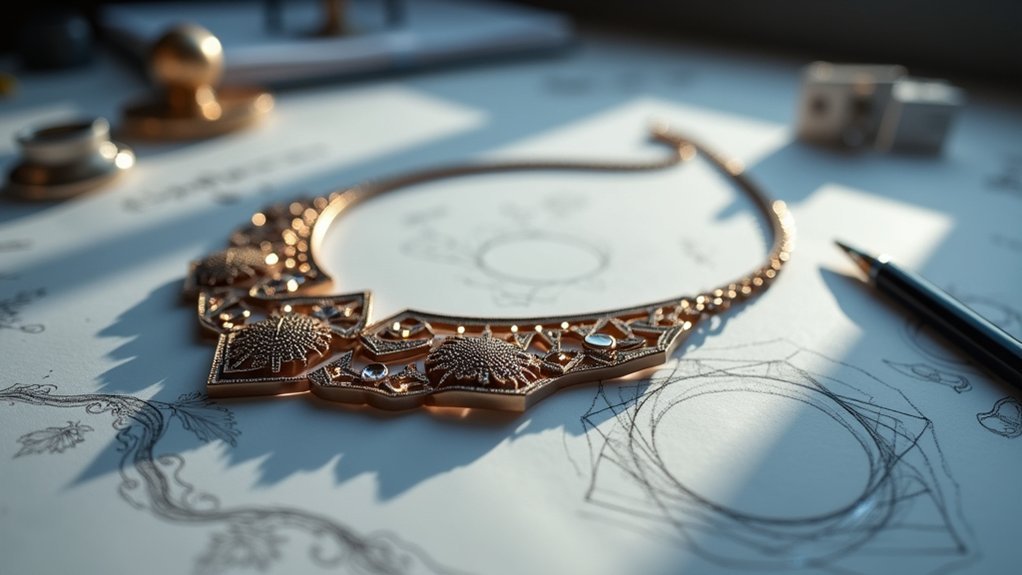
When you need to perfect a design before final production, 3D printing transforms the traditional jewelry development process by enabling rapid prototyping that creates physical models within hours rather than days.
You’ll experience real-time collaboration with your clients, who can provide immediate feedback on tangible prototypes. This instant communication guarantees you can make adjustments that perfectly align with their vision before committing to final production.
Your jewelry designers benefit from accurate production timelines that build trust and transparency with clients. The rapid iteration process eliminates costly traditional mold-making expenses, making extensive customization options financially viable.
You’ll reduce revision cycles while increasing client satisfaction, as they’re actively involved in shaping their piece. This collaborative approach delivers exactly what clients envision.
Strength Testing and Quality Assurance Protocols
You’ll need to establish material durability standards that define minimum strength thresholds for different jewelry applications and wearing conditions.
Your stress test procedures must simulate real-world forces like bending, twisting, and impact to identify potential failure points before production.
You can’t overlook precision measurement protocols that verify dimensional accuracy and structural integrity throughout your quality assurance process.
Material Durability Standards
Because 3D printed jewelry requires exceptional durability to withstand daily wear, manufacturers implement thorough strength testing protocols that identify structural weaknesses before production begins.
You’ll find that material durability standards in the jewelry industry have evolved considerably with 3D printing technology, demanding rigorous evaluation of castable resins and metals for tensile strength and resilience.
Advanced technologies like Stereolithography (SLA) enable you to create intricate designs while maintaining exceptional strength and detail.
Post-production testing verifies that your pieces meet industry durability standards, reducing failure risks.
You can incorporate strength testing feedback directly into your design process, making informed adjustments to materials and designs that enhance your jewelry’s overall quality and longevity for satisfied customers.
Stress Test Procedures
Through thorough stress test procedures, manufacturers subject your 3D printed jewelry to controlled forces that replicate months of normal wear within minutes. These stress tests evaluate your pieces under tensile and compression forces, identifying potential weak points before final production reaches your hands.
Quality assurance protocols guarantee every piece meets professional standards through extensive post-processing inspections. Your jewelry undergoes visual and dimensional checks that verify design specifications and craftsmanship quality.
Advanced materials like castable resins and metal powders enhance your jewelry’s durability, making pieces resilient to everyday wear and tear.
Regular equipment calibration maintains printing accuracy, guaranteeing consistent quality in your final products. This systematic approach validates that your jewelry can withstand typical usage scenarios without failure, delivering the professional-grade reliability you expect from modern 3D printed accessories.
Precision Measurement Protocols
Multiple precision measurement protocols work together to validate your 3D printed jewelry’s structural integrity and dimensional accuracy.
These rigorous strength testing procedures identify weak points in your designs before mold-making, ensuring durability throughout the production process. Your quality assurance protocols must include post-processing inspections and surface finishing evaluations to maintain professional standards.
Advanced digital workflows enable accurate design assessments using CAD software, facilitating real-time adjustments based on strength testing results.
You’ll benefit from specialized machinery that simulates real-world conditions, ensuring your pieces withstand everyday wear.
Continuous improvements in material science produce stronger, castable resins that enhance overall integrity.
Through established quality assurance protocols, you’ll achieve both structural reliability and desired aesthetic qualities in your final products.
Professional-Grade Surface Finishes and Textures
When you’re creating 3D printed jewelry, achieving professional-grade surface finishes requires mastering advanced post-processing techniques that transform raw printed pieces into polished works worthy of industry standards.
You’ll discover that experimenting with various textures during the 3D printing process opens creative possibilities for unique surface qualities that enhance your intricate jewelry designs.
Conducting side-by-side comparisons becomes essential when selecting the most visually appealing finish for your pieces. High-resolution technology paired with meticulous finishing guarantees every detail appears crisp and accurate.
You’ll find that utilizing specialized materials like castable resins creates finishes that aren’t just visually striking but also durable enough for daily wear, setting your work apart in the competitive jewelry market.
Seamless Integration With Traditional Casting Techniques
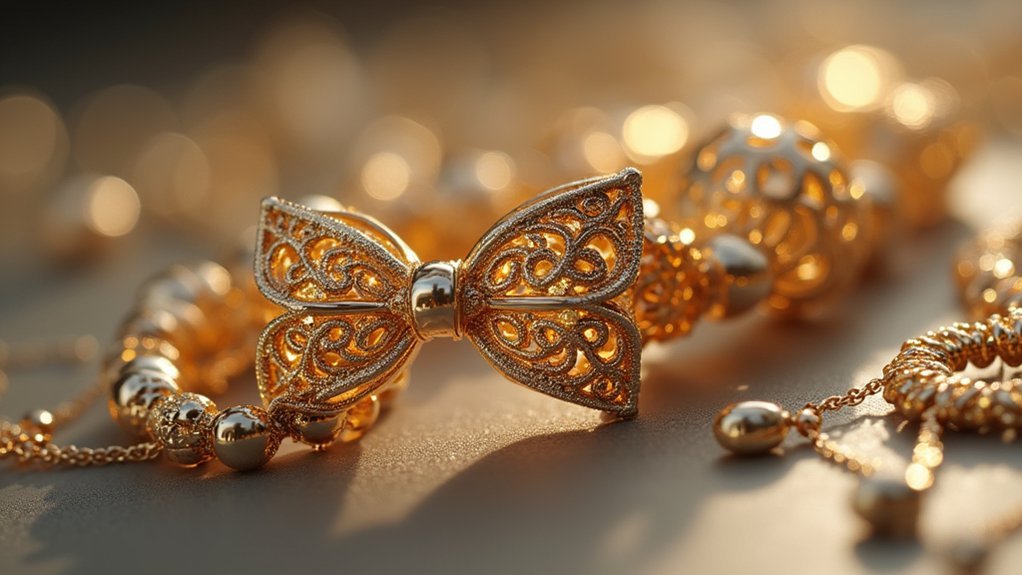
Since digital precision meets centuries-old craftsmanship, you’ll find that 3D printing seamlessly bridges the gap between modern technology and traditional lost-wax casting methods. You can create intricate patterns digitally using CAD software, then print them directly for conventional casting processes.
This integration enhances your jewelry manufacturing workflow by eliminating time-consuming hand-carving while maintaining casting quality standards.
You’ll benefit from rapid prototyping capabilities that allow design testing before final production, reducing material waste and costs. The 3D printed patterns integrate flawlessly with traditional lost-wax casting, enabling you to leverage digital accuracy within established workflows.
This hybrid approach greatly speeds up production times while preserving the high craftsmanship standards that define professional jewelry. You’re fundamentally combining the best of both technological worlds.
Customization Capabilities at Commercial Scale
Through advanced 3D printing technologies, you can now deliver mass customization that transforms individual client preferences into unique jewelry pieces without the traditional cost penalties of bespoke manufacturing.
Your digital workflows enable rapid prototyping, allowing you to iterate designs based on client feedback and reduce time-to-market considerably. Additive manufacturing supports complex geometries impossible with conventional methods, while castable resins and metal printing guarantee commercial-quality results.
| Traditional Method | Printing Jewelry | Advantage |
|---|---|---|
| Weeks for prototypes | Hours for iterations | 10x faster development |
| Limited complexity | Infinite geometries | Unrestricted creativity |
| High custom costs | Scalable pricing | Accessible personalization |
You can integrate custom pieces into standard service offerings, making personalized jewelry accessible to broader markets while maintaining profitability and quality standards.
Industry-Leading Equipment and Technology Standards
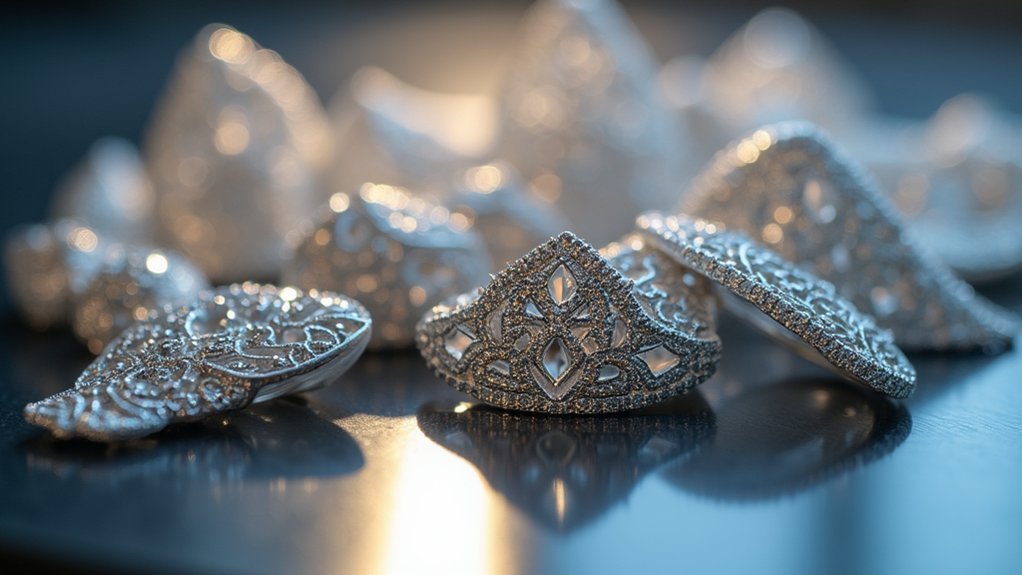
You’ll need precision manufacturing equipment that meets stringent industry standards to produce professional-grade 3D printed jewelry.
Your success depends on advanced material processing technology like SLA and DMLS systems that can achieve layer resolutions as low as 25 microns for intricate details.
You must also guarantee your equipment meets quality certification requirements that validate your production capabilities for commercial jewelry manufacturing.
Precision Manufacturing Equipment Standards
When precision meets artistry in 3D printed jewelry, the equipment you choose determines whether your designs translate from digital concepts into flawless physical pieces.
Your precision manufacturing success depends on stereolithography (SLA) and digital light processing (DLP) 3D printing systems that deliver exceptional detail resolution. You’ll need castable resins specifically formulated for jewelry applications, ensuring structural integrity while capturing intricate filigrees and pavé settings.
Direct metal laser sintering (DMLS) printers enable you to work directly with gold powder, creating complex geometries impossible through traditional methods.
High-resolution settings and precise calibration maintain consistency across production batches.
Post-processing techniques like curing and surface finishing elevate your jewelry pieces to professional standards, transforming raw prints into market-ready products that meet industry expectations.
Advanced Material Processing Technology
Beyond the foundational equipment requirements, advanced material processing technology transforms how you approach jewelry creation through sophisticated systems that push manufacturing boundaries.
Direct Metal Laser Sintering (DMLS) and Material Jetting deliver unparalleled precision for intricate designs, while Stereolithography (SLA) streamlines your production with minimal waste generation.
You’ll achieve previously impossible details like delicate filigrees and complex pavé settings through castable resins and breakthrough materials that enhance pattern quality.
Advanced software including Autodesk 3ds Max and Fusion 360 enables digital visualization and modification before printing, ensuring accuracy while boosting creativity.
Continuous material science advancements produce durable, specialized materials tailored specifically for 3D printing applications.
This evolution in advanced material processing technology revolutionizes jewelry design and manufacturing, delivering professional-grade strength and integrity in your final pieces.
Quality Certification Requirements
Professional certification demands in 3D printed jewelry manufacturing require stringent adherence to industry-leading equipment and technology standards that guarantee precision, safety, and durability.
You’ll need to utilize specialized machines like Stereolithography (SLA) and Direct Metal Laser Sintering (DMLS) to meet quality certification requirements. These technologies enable intricate model creation with exceptional accuracy.
When incorporating precious metals like gold and silver into your 3D printing technology processes, you must comply with material safety standards using non-toxic, high-quality materials.
Castable resins are essential for certification compliance. You’ll also need to implement thorough quality assurance processes, including strength and durability testing before final production.
Additionally, integrating CAD software with your 3D printing technology enhances professional quality through rapid prototyping capabilities.
Expert Design Skills and Technical Craftsmanship
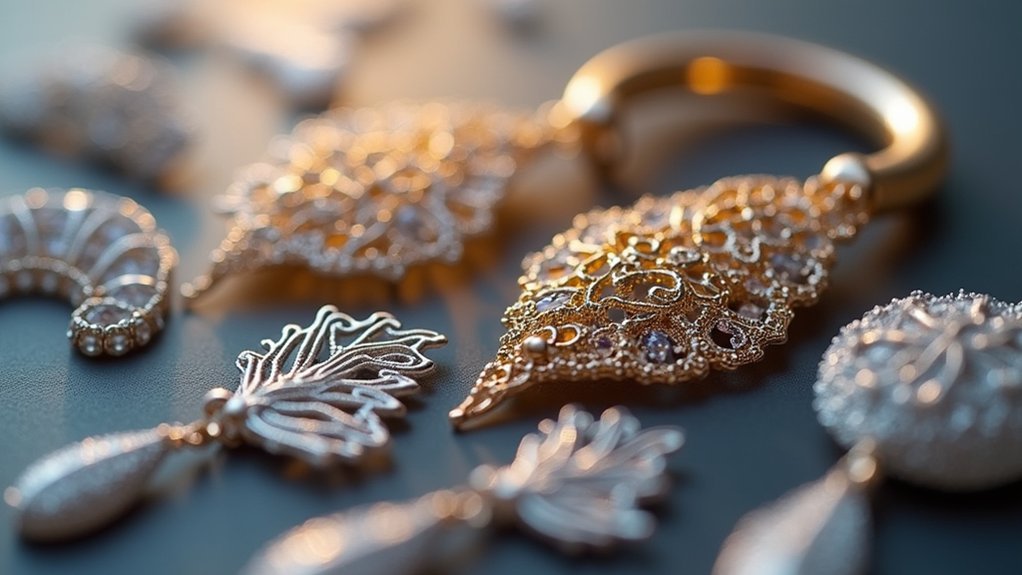
Although traditional jewelry-making relies on time-tested techniques, 3D printing demands a unique fusion of digital expertise and manufacturing knowledge that’ll transform how you approach design.
Your expert design skills must leverage complex geometries impossible through conventional methods, requiring mastery of CAD software like Autodesk 3ds Max and Fusion 360 for precise visualization.
Complex geometries impossible through traditional methods require mastering advanced CAD software like 3ds Max and Fusion 360 for precise digital visualization.
Technical craftsmanship in 3D printing involves understanding material jetting and direct metal laser sintering to achieve high-quality results.
You’ll need proficiency in post-processing techniques, including curing and surface finishing, to enhance aesthetic qualities and durability.
Staying competitive requires continuous adaptation to emerging materials like castable resins and advancements in metal printing technologies that constantly reshape professional jewelry production.
Efficient Production Workflows and Time Management
Mastering these technical skills sets the foundation for implementing streamlined production systems that’ll maximize your output while maintaining quality standards. Efficient production workflows in 3D printing transform how you approach jewelry creation, enabling prototype development within hours rather than days. You’ll integrate CAD software with specialized printers to shift seamlessly from design to production, reducing material waste and ensuring precision.
| Workflow Stage | Time Impact | Cost Benefit |
|---|---|---|
| Digital Design | Real-time client collaboration | Reduced revision cycles |
| Prototype Creation | Hours vs. traditional days | Lower material waste |
| Final Production | On-demand manufacturing | Eliminated inventory costs |
Advanced techniques like material jetting and direct metal laser sintering enable intricate design modifications and quick market responses. You’ll save significant time and cost through on-demand production, eliminating excess inventory while maintaining quality standards.
Professional Repair and Reproduction Services
When jewelry breaks or gets damaged, 3D printing revolutionizes how you’ll approach repair and reproduction work. You can precisely reproduce damaged pieces, ensuring intricate designs are replicated accurately and efficiently for professional services.
The ability to use the same mold as the original simplifies your replacement process, eliminating the need for crafting and fitting small metal components during repairs.
Advanced technologies like material jetting and direct metal laser sintering let you produce high-quality replacements meeting original specifications. Rapid prototyping greatly reduces your repair turnaround times, enhancing customer satisfaction through quick, reliable service.
Digital workflows integrated into traditional jewelry making techniques allow you to easily adjust designs based on customer feedback, improving your production process and reproduction results.
Frequently Asked Questions
How Does 3D Printing Jewelry Work?
You’ll design jewelry using CAD software, then your 3D printer creates detailed wax patterns with castable resin. You’ll cast these patterns using traditional lost-wax methods, then cure and finish for professional results.
What Is the Most Popular Method of 3D Printing for Professionals?
You’ll find Stereolithography (SLA) is the most popular method among jewelry professionals. It captures fine details and intricate designs perfectly, using UV lasers to cure liquid resin for exceptionally smooth finishes.
How to 3D Print in High Quality?
You’ll achieve high-quality 3D prints by using high-resolution printers, selecting appropriate materials like specialized resins, optimizing your CAD models, and conducting thorough post-processing including proper curing and surface finishing.
Are 3D Printed Goods as Good as Those Manufactured Traditionally?
You’ll find 3D printed goods can match traditional quality through advanced techniques like Direct Metal Laser Sintering. They’re often superior for intricate designs while reducing waste and production time considerably.
In Summary
You’ll achieve truly professional 3D printed jewelry when you master advanced materials, precision digital workflows, and complex geometries impossible with traditional methods. You’re leveraging rapid prototyping for seamless client collaboration while maintaining rigorous quality standards. You’ve invested in industry-leading equipment and developed expert technical skills. You’re optimizing production efficiency and offering extensive services. Professional 3D jewelry isn’t just about technology—it’s about combining cutting-edge tools with traditional craftsmanship excellence.



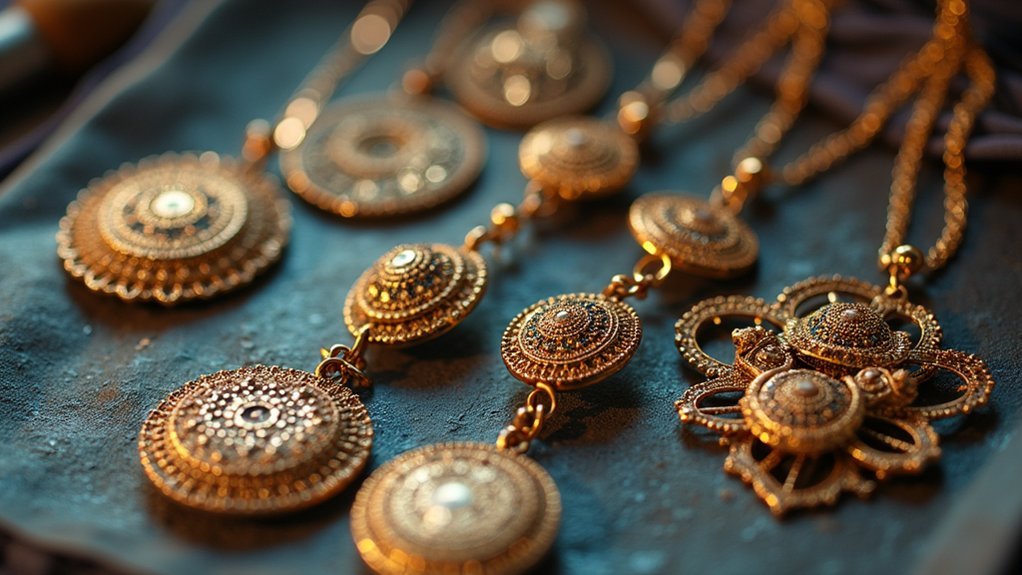
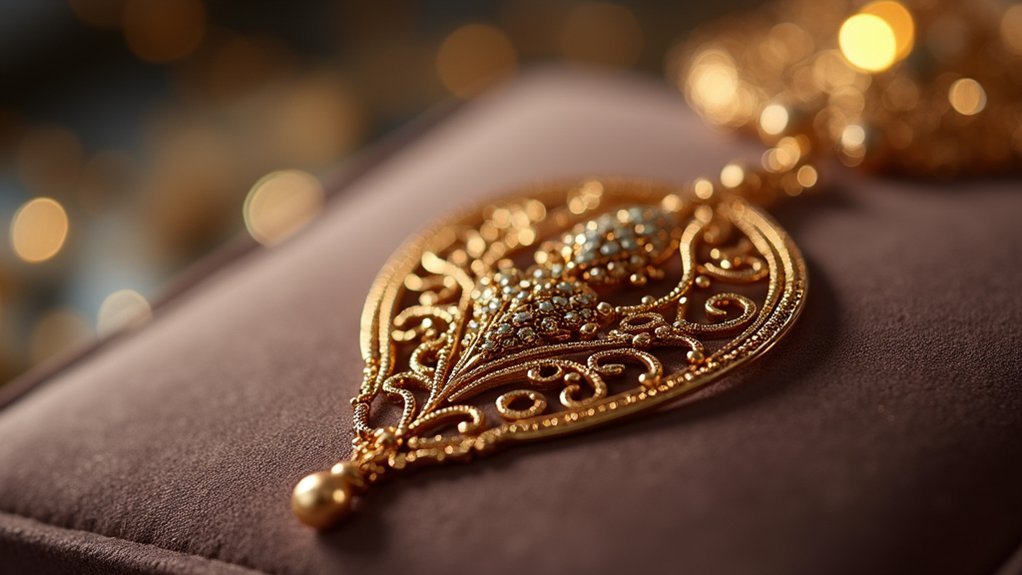
Leave a Reply